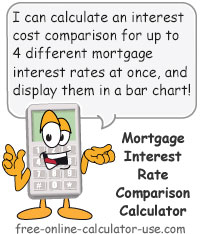IMPORTANT: Numeric entry fields must not contain dollar signs, percent signs, commas, spaces, etc. (only digits 0-9 and decimal points are allowed).
Click the Terms tab above for a more detailed description of each entry.
Step #1:
Enter the mortgage loan amount.
Step #2:
Enter the term of the mortgage in the number of years.
Step #3:
If you would like to be made aware of how many hours you will need to work to pay the interest charges on the mortgage, enter your Real Hourly Wage. If not, leave the RHW field blank.
Step #4:
Select the number of different rates you would like to compare. At least two will be required for the rate comparison report.
Step #5:
For each entry row, select an interest rate to compare.
Step #6:
Tap the "Create Comparison" button. This will generate a Rate Comparison Chart, a Mortgage Interest Cost bar graph, and a button for creating a printer friendly report.


Follow me on any of the social media sites below and be among the first to get a sneak peek at the newest and coolest calculators that are being added or updated each month.